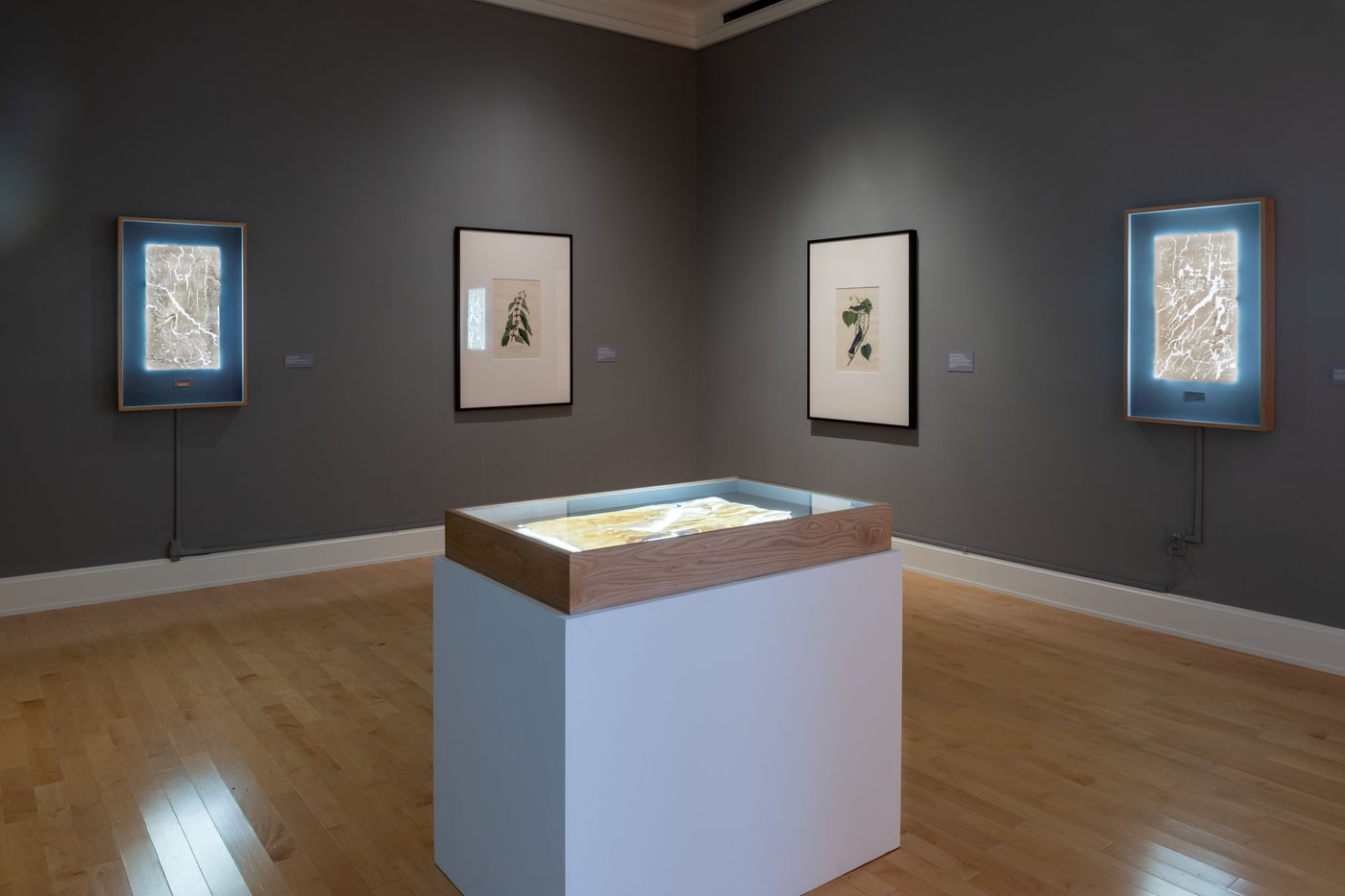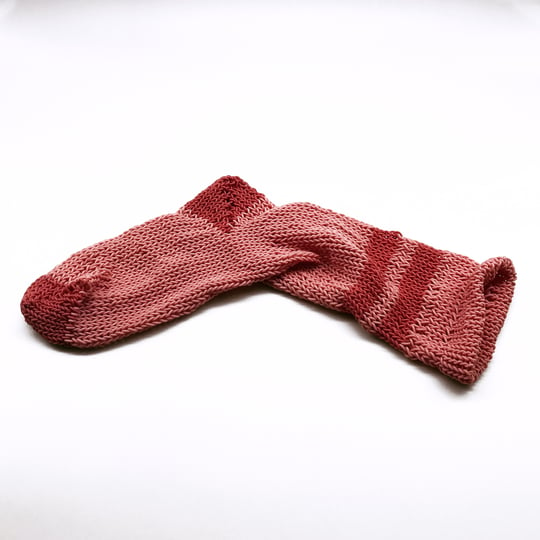
Elizabeth M. Webb: a bearing tree is a witness; an oak is an echo, currently on view at the Jule Collins Smith Museum of Fine Art at Auburn University, is one of an ongoing series of exhibitions collectively titled Radical Naturalism, in which contemporary artists whose work engages environmental or ecological themes are invited to make work in dialogue with the museum’s permanent collection of etchings by famed nineteenth-century ornithologist, John James Audubon. This series of exhibitions offers a reassessment of Audubon’s complicated legacy, challenging aspects of the worldview that it represents.
Interspersed among Webb’s framed works and readymade sculptures occupying two of the museum’s galleries are a selection of five etchings from the first edition of Audubon’s The Birds of America (1827-38) depicting various birds their natural habitats near where the museum is located. A Blue Grosbeak is perched on branches of Dogwood Cornus-florida, and Whip-poor-wills flit among the leaves of a Black Oak. Like Audubon’s etchings, Webb’s work in the exhibition also has a direct relationship to the museum’s geographical surroundings. It can all be traced to a plot of land near the museum—once a plantation—that had been settled by and passed down through generations of her ancestors, some of whom had been Black and others white.
That Webb’s family’s property was deeded in 1834 at the same time that Audubon was actively recording and classifying North America’s avifauna is illustrative of the dual Enlightenment concepts of property and control over the natural world that became dominant in the late eighteenth and early nineteenth centuries. Audubon’s etchings contributed to a system of classification that put humans at the top of a species hierarchy. Like classification, the mechanisms Webb explores in her work were another means of imposing order on the natural world, of claiming and overwriting land according to a colonial logic.

The exhibition opens with a series of US Department of Agriculture maps of the land where the property was located printed in a warm sepia tone using soil drawn from the land. Rather than being shown contiguously, the prints are broken up into four squares and displayed in a grid with one square displaced onto the opposite wall of the gallery. An antique stereoscope—an instrument used by cartographers in the nineteenth century to create three-dimensional views of land and topography—sits on a small shelf near the maps. And a length of chain winds its way across the floor along the perimeter of one gallery into the next, another surveying instrument used to measure distance or plot out an area in square chains, the standard unit of measurement at the time Webb’s ancestors settled in the area.
Across the room, three Oak wood-framed lightboxes glow softly, two hung on the wall and the other lying flat atop a pedestal. Inside are thin sheets of porcelain imprinted with barely legible text. This series of lightbox works continues in the second gallery, where they are displayed in a grid. Illuminated from behind, the translucent porcelain sheets resemble paper, and are presented here the way archival documents are often studied or displayed in museum contexts—in highly controlled, hermetically sealed boxes designed to protect what’s inside. They appear fragile, further evidenced by the fact that they’re all shattered to varying degrees, their fissures taking on a cartographic quality echoing the map in the first gallery.
Despite its apparent fragility as a material, porcelain carries conceptual weight. Originating in China, porcelain rose in popularity in Western Europe and the United States in the eighteenth and nineteenth centuries during a period of increased globalization and Western colonial expansion, and became a marker of wealth and affluence prized for its purity, whiteness, and imperviousness to staining. In her book, The Intimacies of Four Continents (2015), Lisa Lowe argues that the fetishization of these qualities reflects an anxiety about the threat of various forms of contamination with the increased movement of people and goods around the globe. In the Southeastern U.S., one form of this was a fixation on the idea of racial purity, the determining factor at one point in the history of the U.S. between whether or not a person could be considered property. The hard line between Black and white was necessary to enforce racial subjugation through structural means.

Webb’s porcelain works invoke these structural means through the reproduction of wills, property deeds, and plat maps, and through collaged snippets of familial oral histories recounting instances of coming up against structural barriers in day-to-day life. Though the text is barely legible, a narrative emerges about segregated neighborhoods (“the Black neighborhoods still had outhouses”), housing discrimination (“they called us and [said] they weren’t going to sell the house after all”) and family members who passed for white, among other anecdotes. Webb combines these stories with field notes from a land survey that used trees to delineate property boundaries, drawing a connection between land barriers and racial barriers that points to the historical linkages between property ownership and systems of racial oppression.
In these works and throughout the exhibition, there is a palpable friction between material conditions and abstract systems or structures, between a lived experience of place and place as a construct. Nowhere is this better demonstrated than in Webb’s film, Boundary Exercise (On Perambulation) from 2022, a silent 16mm film in which she retraces the boundary line of the property that had belonged to her ancestors using various devices for measuring and surveying the land, some of which would have been used in the nineteenth century. In contrast to the way Audubon’s etchings reflect the use of empirical observation in service of taxonomy, Webb’s work invokes these devices only to undermine their authority.
The camera descends from an aerial view over a forest of Oak and Pine trees, and then places the viewer on the ground, where the artist marks tree trunks with spray paint and at various moments, holds a lens up to the camera and turns it, causing the image to focus and blur, or to be turned upside down. On a table strewn with survey field notes handwritten in blue ink, she traces the outline of an oak leaf using an antique brass instrument. Towards the end she unspools a reel of 16mm film in a line on the ground as a surveyor would a chain, and then buries it in the dirt. Remnants of this act appear in the form of scratches and spots of yellow and green that dance across the projected image. The length or duration of the film is given as 264’ or one square chain or 7 min 20 sec.

The film is all of these and it is none of them. With these “or’s” Webb unsettles the stability of a single measurement or a singular perspective. Her abiding interest throughout the exhibition in the different mechanisms for measuring, plotting, and mapping land that were used in the nineteenth century similarly pokes holes in any de facto assumptions about land as a resource and commodity, as something that can be partitioned and sold. She demonstrates how this system is not a given, but rather, is highly constructed in a way that is almost completely detached from the material realities of place. At the same time, she carves out space in the exhibition—in maps printed with dirt, documents in shattered porcelain, film corroded by soil—that open up possibilities for other ways of being with the land, of allowing it to make its mark.




